BCO6653 - CIO Role Evolution: IT Strategy and Business Impact
VerifiedAdded on 2023/04/21
|17
|3709
|174
Report
AI Summary
This report explores the evolving role of the Chief Information Officer (CIO) in modern organizations, emphasizing the shift from a technical focus to a strategic leadership position. The CIO's role is examined in the context of digital transformation, IT strategy, and the integration of new technologies. It discusses how CIOs are increasingly involved in business strategy, innovation, and ensuring the alignment of IT initiatives with overall business goals. The report also highlights the importance of CIOs in managing IT costs, driving business model innovation, and securing organizational assets, with a focus on areas such as analytics, architecture, security, optimization, and growth. The evolving role requires CIOs to be proactive in leveraging technologies like cloud computing, mobile solutions, and artificial intelligence to enhance business processes and achieve a competitive advantage. The report concludes that the CIO's role has transformed from a technology custodian to a key driver of business growth and digital transformation.
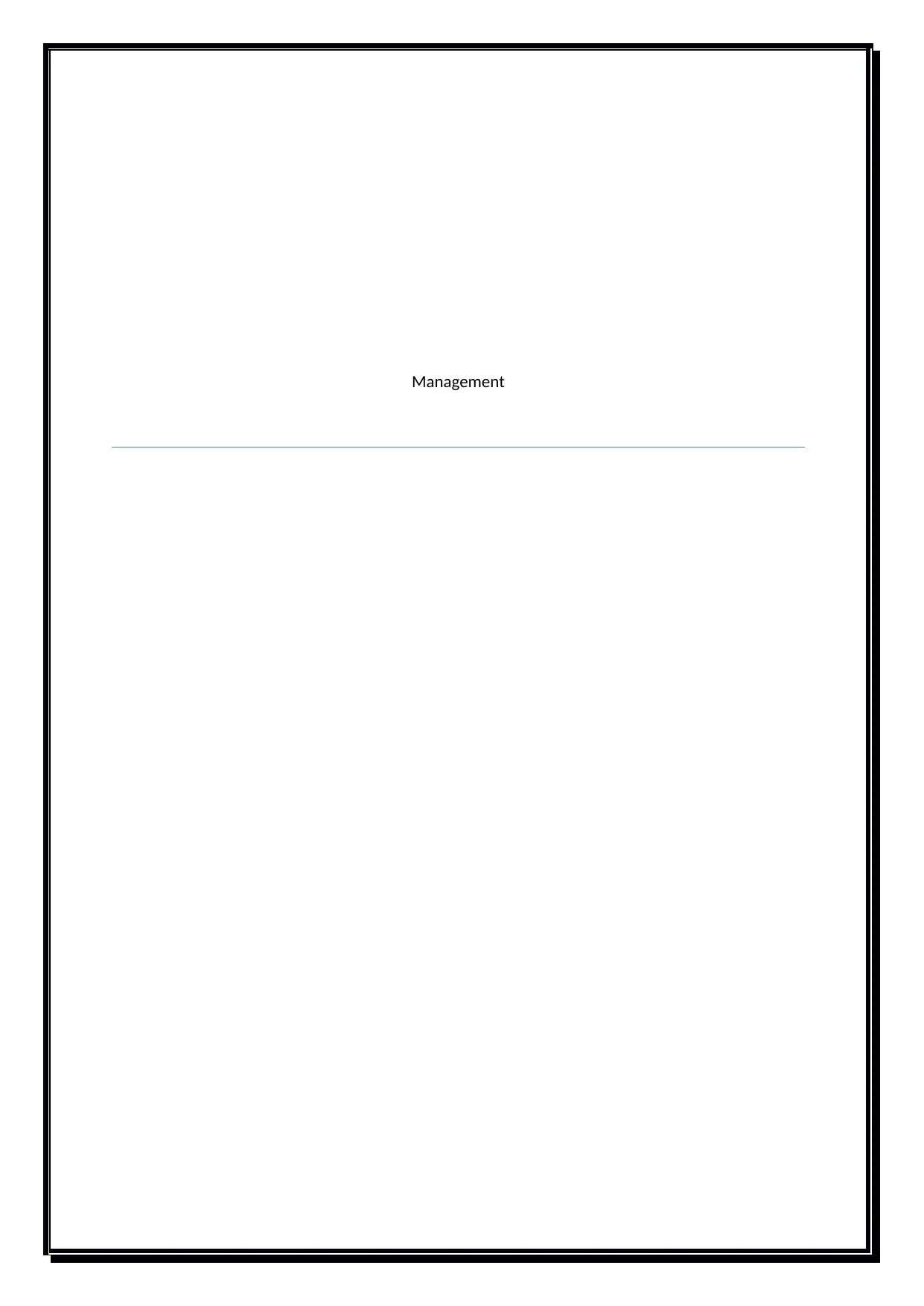
Management
Paraphrase This Document
Need a fresh take? Get an instant paraphrase of this document with our AI Paraphraser
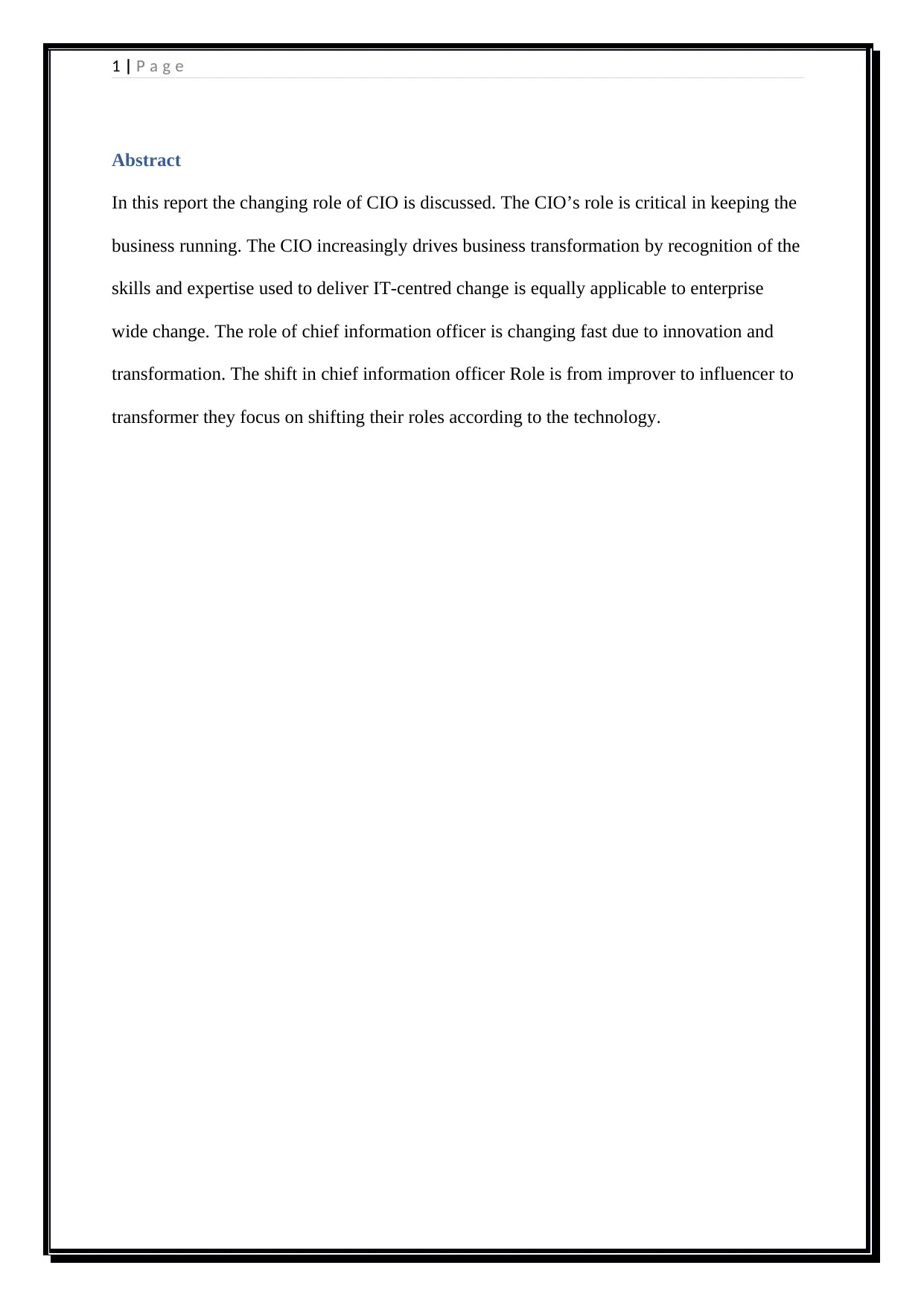
1 | P a g e
Abstract
In this report the changing role of CIO is discussed. The CIO’s role is critical in keeping the
business running. The CIO increasingly drives business transformation by recognition of the
skills and expertise used to deliver IT-centred change is equally applicable to enterprise
wide change. The role of chief information officer is changing fast due to innovation and
transformation. The shift in chief information officer Role is from improver to influencer to
transformer they focus on shifting their roles according to the technology.
Abstract
In this report the changing role of CIO is discussed. The CIO’s role is critical in keeping the
business running. The CIO increasingly drives business transformation by recognition of the
skills and expertise used to deliver IT-centred change is equally applicable to enterprise
wide change. The role of chief information officer is changing fast due to innovation and
transformation. The shift in chief information officer Role is from improver to influencer to
transformer they focus on shifting their roles according to the technology.
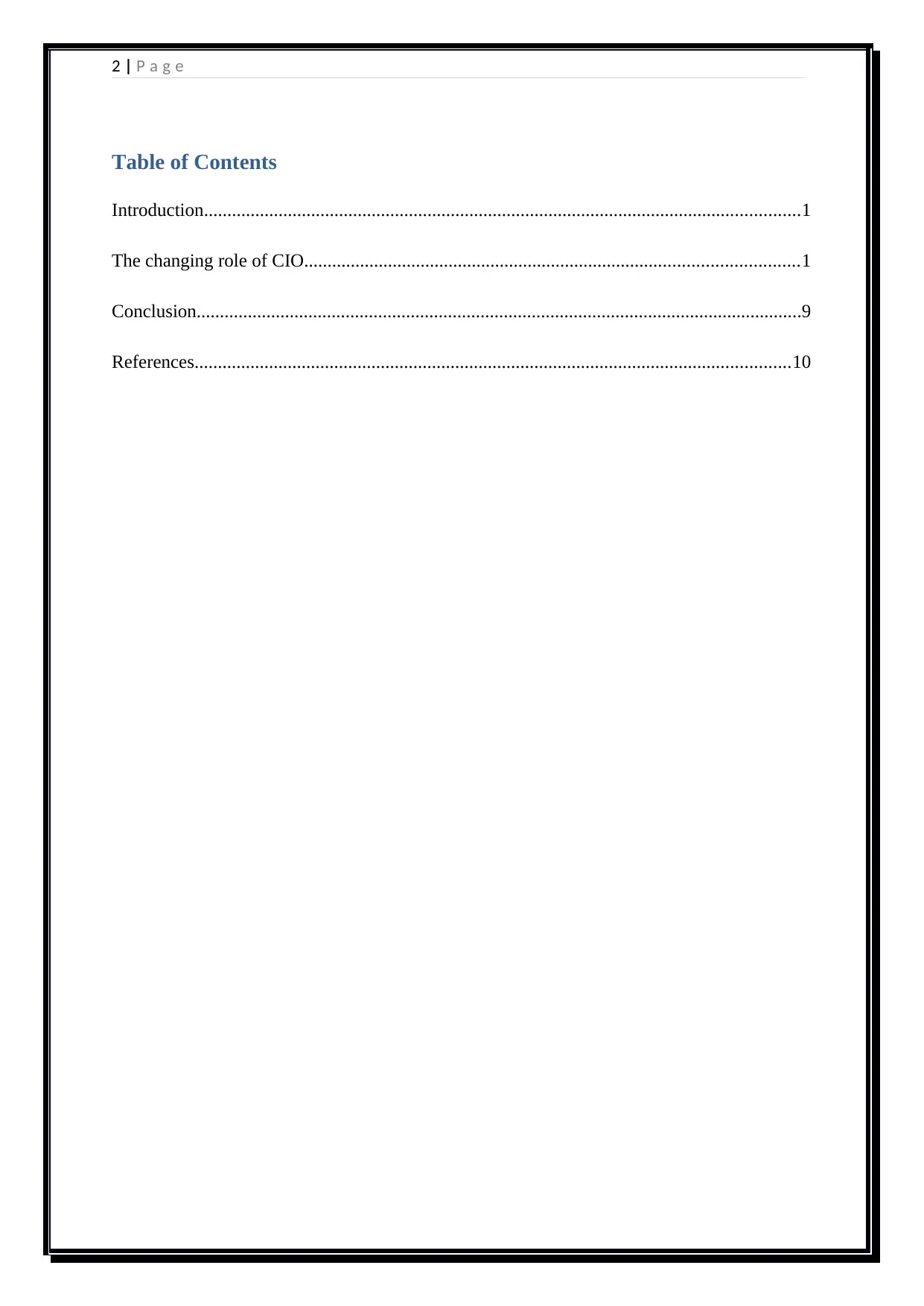
2 | P a g e
Table of Contents
Introduction................................................................................................................................1
The changing role of CIO..........................................................................................................1
Conclusion..................................................................................................................................9
References................................................................................................................................10
Table of Contents
Introduction................................................................................................................................1
The changing role of CIO..........................................................................................................1
Conclusion..................................................................................................................................9
References................................................................................................................................10
⊘ This is a preview!⊘
Do you want full access?
Subscribe today to unlock all pages.

Trusted by 1+ million students worldwide
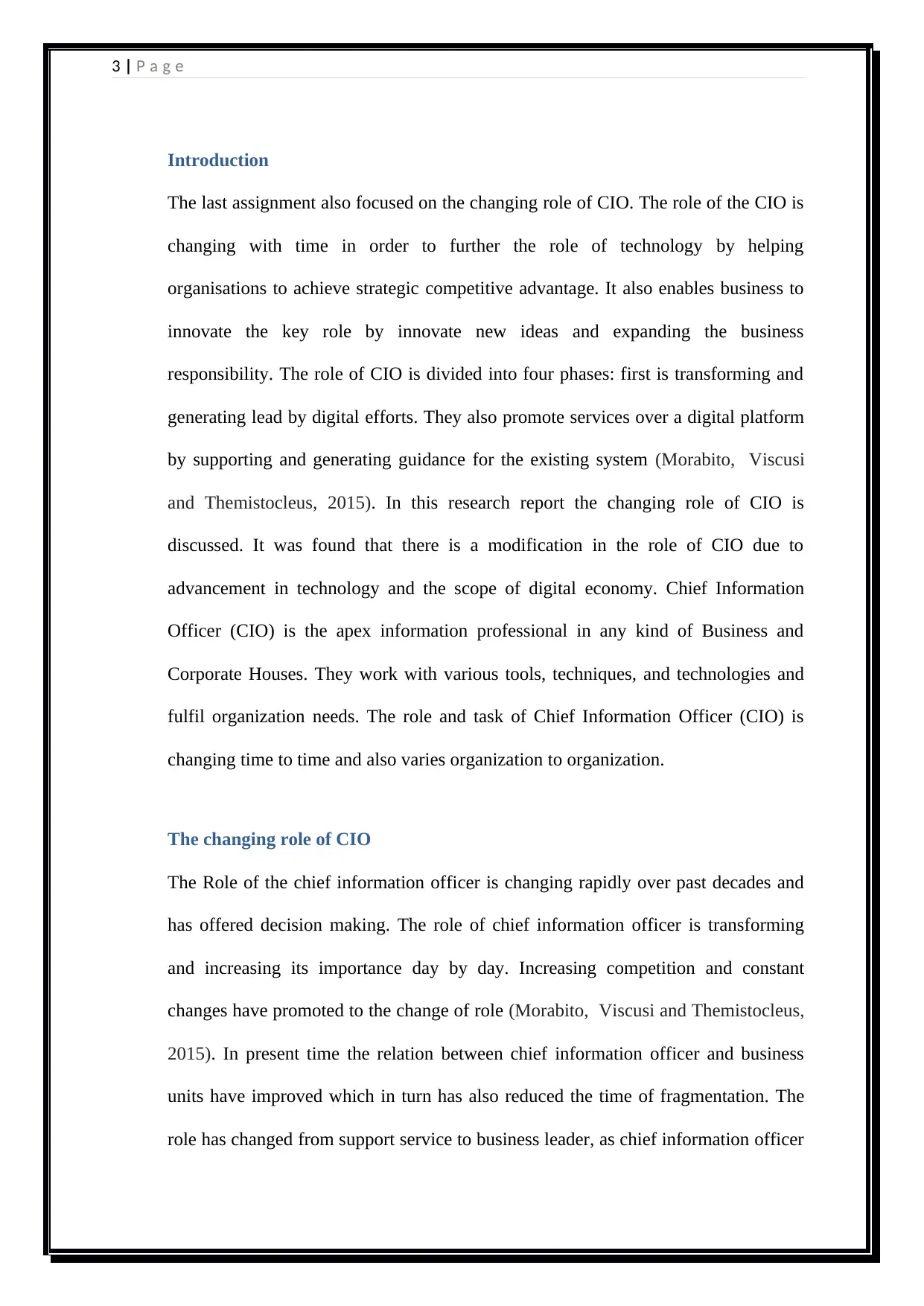
3 | P a g e
Introduction
The last assignment also focused on the changing role of CIO. The role of the CIO is
changing with time in order to further the role of technology by helping
organisations to achieve strategic competitive advantage. It also enables business to
innovate the key role by innovate new ideas and expanding the business
responsibility. The role of CIO is divided into four phases: first is transforming and
generating lead by digital efforts. They also promote services over a digital platform
by supporting and generating guidance for the existing system (Morabito, Viscusi
and Themistocleus, 2015). In this research report the changing role of CIO is
discussed. It was found that there is a modification in the role of CIO due to
advancement in technology and the scope of digital economy. Chief Information
Officer (CIO) is the apex information professional in any kind of Business and
Corporate Houses. They work with various tools, techniques, and technologies and
fulfil organization needs. The role and task of Chief Information Officer (CIO) is
changing time to time and also varies organization to organization.
The changing role of CIO
The Role of the chief information officer is changing rapidly over past decades and
has offered decision making. The role of chief information officer is transforming
and increasing its importance day by day. Increasing competition and constant
changes have promoted to the change of role (Morabito, Viscusi and Themistocleus,
2015). In present time the relation between chief information officer and business
units have improved which in turn has also reduced the time of fragmentation. The
role has changed from support service to business leader, as chief information officer
Introduction
The last assignment also focused on the changing role of CIO. The role of the CIO is
changing with time in order to further the role of technology by helping
organisations to achieve strategic competitive advantage. It also enables business to
innovate the key role by innovate new ideas and expanding the business
responsibility. The role of CIO is divided into four phases: first is transforming and
generating lead by digital efforts. They also promote services over a digital platform
by supporting and generating guidance for the existing system (Morabito, Viscusi
and Themistocleus, 2015). In this research report the changing role of CIO is
discussed. It was found that there is a modification in the role of CIO due to
advancement in technology and the scope of digital economy. Chief Information
Officer (CIO) is the apex information professional in any kind of Business and
Corporate Houses. They work with various tools, techniques, and technologies and
fulfil organization needs. The role and task of Chief Information Officer (CIO) is
changing time to time and also varies organization to organization.
The changing role of CIO
The Role of the chief information officer is changing rapidly over past decades and
has offered decision making. The role of chief information officer is transforming
and increasing its importance day by day. Increasing competition and constant
changes have promoted to the change of role (Morabito, Viscusi and Themistocleus,
2015). In present time the relation between chief information officer and business
units have improved which in turn has also reduced the time of fragmentation. The
role has changed from support service to business leader, as chief information officer
Paraphrase This Document
Need a fresh take? Get an instant paraphrase of this document with our AI Paraphraser
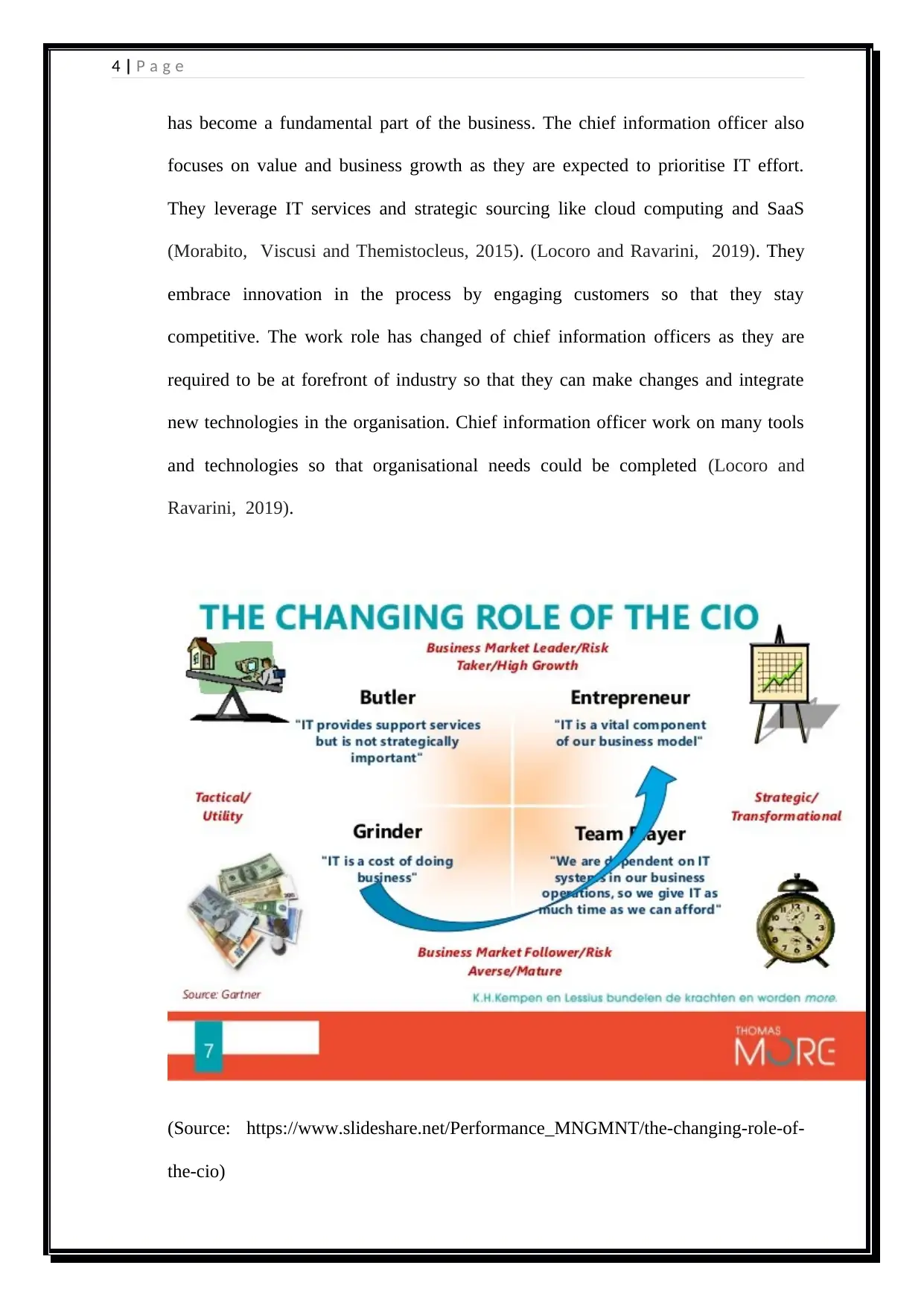
4 | P a g e
has become a fundamental part of the business. The chief information officer also
focuses on value and business growth as they are expected to prioritise IT effort.
They leverage IT services and strategic sourcing like cloud computing and SaaS
(Morabito, Viscusi and Themistocleus, 2015). (Locoro and Ravarini, 2019). They
embrace innovation in the process by engaging customers so that they stay
competitive. The work role has changed of chief information officers as they are
required to be at forefront of industry so that they can make changes and integrate
new technologies in the organisation. Chief information officer work on many tools
and technologies so that organisational needs could be completed (Locoro and
Ravarini, 2019).
(Source: https://www.slideshare.net/Performance_MNGMNT/the-changing-role-of-
the-cio)
has become a fundamental part of the business. The chief information officer also
focuses on value and business growth as they are expected to prioritise IT effort.
They leverage IT services and strategic sourcing like cloud computing and SaaS
(Morabito, Viscusi and Themistocleus, 2015). (Locoro and Ravarini, 2019). They
embrace innovation in the process by engaging customers so that they stay
competitive. The work role has changed of chief information officers as they are
required to be at forefront of industry so that they can make changes and integrate
new technologies in the organisation. Chief information officer work on many tools
and technologies so that organisational needs could be completed (Locoro and
Ravarini, 2019).
(Source: https://www.slideshare.net/Performance_MNGMNT/the-changing-role-of-
the-cio)
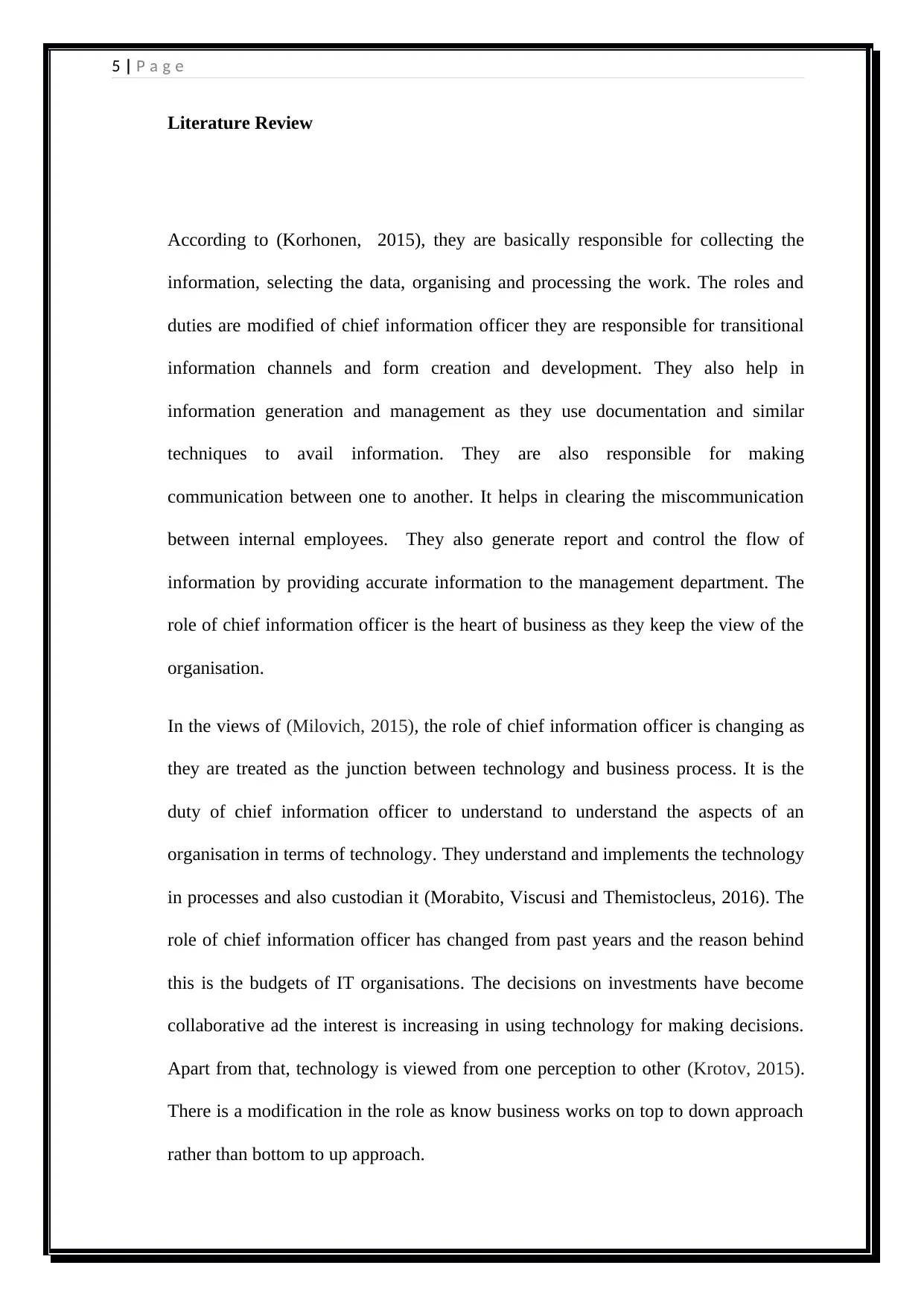
5 | P a g e
Literature Review
According to (Korhonen, 2015), they are basically responsible for collecting the
information, selecting the data, organising and processing the work. The roles and
duties are modified of chief information officer they are responsible for transitional
information channels and form creation and development. They also help in
information generation and management as they use documentation and similar
techniques to avail information. They are also responsible for making
communication between one to another. It helps in clearing the miscommunication
between internal employees. They also generate report and control the flow of
information by providing accurate information to the management department. The
role of chief information officer is the heart of business as they keep the view of the
organisation.
In the views of (Milovich, 2015), the role of chief information officer is changing as
they are treated as the junction between technology and business process. It is the
duty of chief information officer to understand to understand the aspects of an
organisation in terms of technology. They understand and implements the technology
in processes and also custodian it (Morabito, Viscusi and Themistocleus, 2016). The
role of chief information officer has changed from past years and the reason behind
this is the budgets of IT organisations. The decisions on investments have become
collaborative ad the interest is increasing in using technology for making decisions.
Apart from that, technology is viewed from one perception to other (Krotov, 2015).
There is a modification in the role as know business works on top to down approach
rather than bottom to up approach.
Literature Review
According to (Korhonen, 2015), they are basically responsible for collecting the
information, selecting the data, organising and processing the work. The roles and
duties are modified of chief information officer they are responsible for transitional
information channels and form creation and development. They also help in
information generation and management as they use documentation and similar
techniques to avail information. They are also responsible for making
communication between one to another. It helps in clearing the miscommunication
between internal employees. They also generate report and control the flow of
information by providing accurate information to the management department. The
role of chief information officer is the heart of business as they keep the view of the
organisation.
In the views of (Milovich, 2015), the role of chief information officer is changing as
they are treated as the junction between technology and business process. It is the
duty of chief information officer to understand to understand the aspects of an
organisation in terms of technology. They understand and implements the technology
in processes and also custodian it (Morabito, Viscusi and Themistocleus, 2016). The
role of chief information officer has changed from past years and the reason behind
this is the budgets of IT organisations. The decisions on investments have become
collaborative ad the interest is increasing in using technology for making decisions.
Apart from that, technology is viewed from one perception to other (Krotov, 2015).
There is a modification in the role as know business works on top to down approach
rather than bottom to up approach.
⊘ This is a preview!⊘
Do you want full access?
Subscribe today to unlock all pages.

Trusted by 1+ million students worldwide

6 | P a g e
(Source: https://www.znetlive.com/blog/changing-role-of-the-cio-with-cloud-
adoption/)
According to (Krotov, 2015), Chief information officer is responsible for various
actions in an organisation like managing cost, keeping the needs and requirements
updated, acting as an information brokers, delivering the changes and bringing new
business model innovation. It is the duty of chief information officer to control and
monitor the impact of information technology on an organisation. They also assure
that security needs are running up correctly and offer insight support for business
decisions. The role of chief information officer is to generate new ideas and solutions
so that business processes gets enhanced by becoming active business partner
(Kratzer, Lohmann, Roeglinger, Rupprecht and zur Muehlen, 2018). Then they
prepare and develop ways through change can be implemented. They shape the
(Source: https://www.znetlive.com/blog/changing-role-of-the-cio-with-cloud-
adoption/)
According to (Krotov, 2015), Chief information officer is responsible for various
actions in an organisation like managing cost, keeping the needs and requirements
updated, acting as an information brokers, delivering the changes and bringing new
business model innovation. It is the duty of chief information officer to control and
monitor the impact of information technology on an organisation. They also assure
that security needs are running up correctly and offer insight support for business
decisions. The role of chief information officer is to generate new ideas and solutions
so that business processes gets enhanced by becoming active business partner
(Kratzer, Lohmann, Roeglinger, Rupprecht and zur Muehlen, 2018). Then they
prepare and develop ways through change can be implemented. They shape the
Paraphrase This Document
Need a fresh take? Get an instant paraphrase of this document with our AI Paraphraser
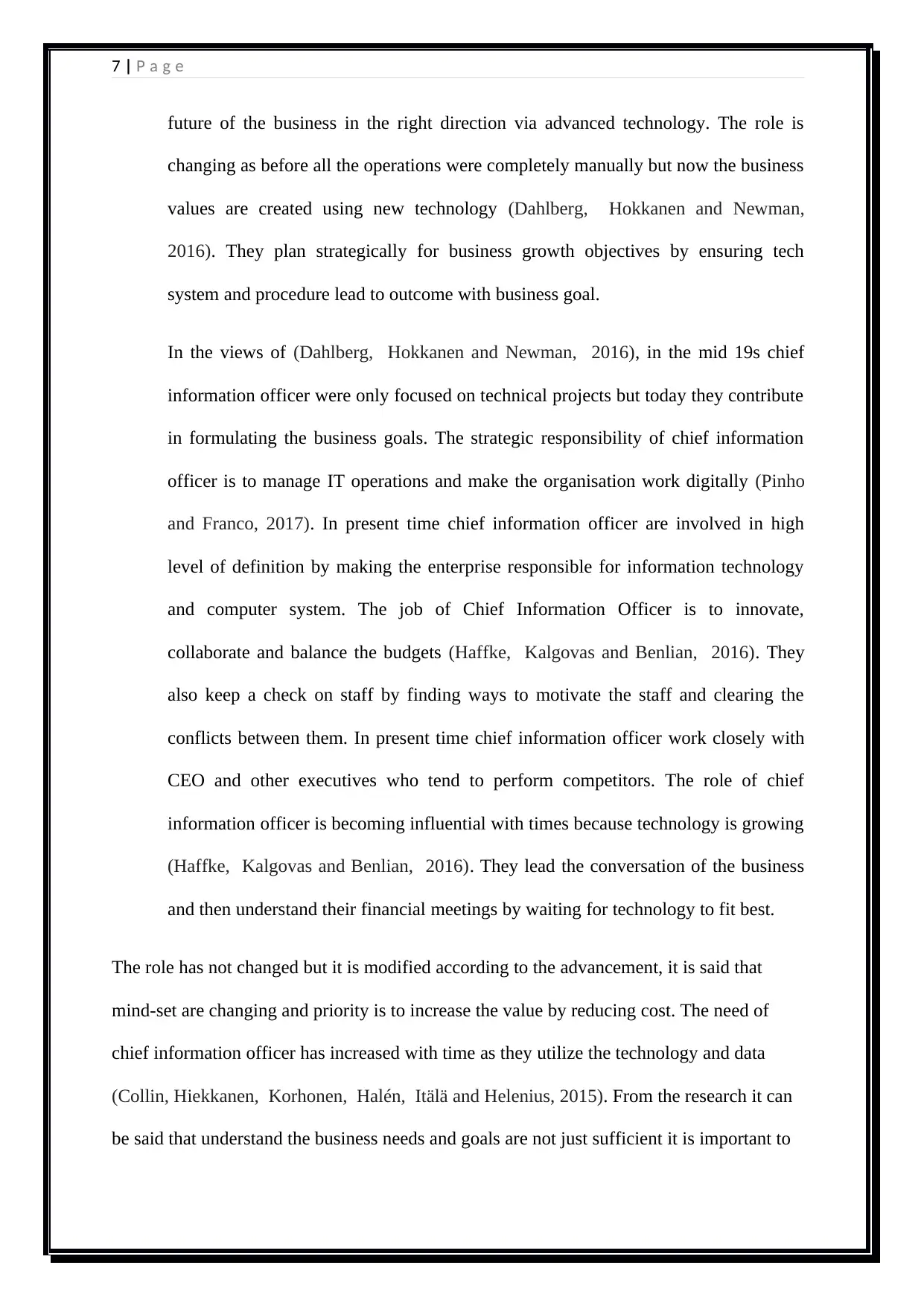
7 | P a g e
future of the business in the right direction via advanced technology. The role is
changing as before all the operations were completely manually but now the business
values are created using new technology (Dahlberg, Hokkanen and Newman,
2016). They plan strategically for business growth objectives by ensuring tech
system and procedure lead to outcome with business goal.
In the views of (Dahlberg, Hokkanen and Newman, 2016), in the mid 19s chief
information officer were only focused on technical projects but today they contribute
in formulating the business goals. The strategic responsibility of chief information
officer is to manage IT operations and make the organisation work digitally (Pinho
and Franco, 2017). In present time chief information officer are involved in high
level of definition by making the enterprise responsible for information technology
and computer system. The job of Chief Information Officer is to innovate,
collaborate and balance the budgets (Haffke, Kalgovas and Benlian, 2016). They
also keep a check on staff by finding ways to motivate the staff and clearing the
conflicts between them. In present time chief information officer work closely with
CEO and other executives who tend to perform competitors. The role of chief
information officer is becoming influential with times because technology is growing
(Haffke, Kalgovas and Benlian, 2016). They lead the conversation of the business
and then understand their financial meetings by waiting for technology to fit best.
The role has not changed but it is modified according to the advancement, it is said that
mind-set are changing and priority is to increase the value by reducing cost. The need of
chief information officer has increased with time as they utilize the technology and data
(Collin, Hiekkanen, Korhonen, Halén, Itälä and Helenius, 2015). From the research it can
be said that understand the business needs and goals are not just sufficient it is important to
future of the business in the right direction via advanced technology. The role is
changing as before all the operations were completely manually but now the business
values are created using new technology (Dahlberg, Hokkanen and Newman,
2016). They plan strategically for business growth objectives by ensuring tech
system and procedure lead to outcome with business goal.
In the views of (Dahlberg, Hokkanen and Newman, 2016), in the mid 19s chief
information officer were only focused on technical projects but today they contribute
in formulating the business goals. The strategic responsibility of chief information
officer is to manage IT operations and make the organisation work digitally (Pinho
and Franco, 2017). In present time chief information officer are involved in high
level of definition by making the enterprise responsible for information technology
and computer system. The job of Chief Information Officer is to innovate,
collaborate and balance the budgets (Haffke, Kalgovas and Benlian, 2016). They
also keep a check on staff by finding ways to motivate the staff and clearing the
conflicts between them. In present time chief information officer work closely with
CEO and other executives who tend to perform competitors. The role of chief
information officer is becoming influential with times because technology is growing
(Haffke, Kalgovas and Benlian, 2016). They lead the conversation of the business
and then understand their financial meetings by waiting for technology to fit best.
The role has not changed but it is modified according to the advancement, it is said that
mind-set are changing and priority is to increase the value by reducing cost. The need of
chief information officer has increased with time as they utilize the technology and data
(Collin, Hiekkanen, Korhonen, Halén, Itälä and Helenius, 2015). From the research it can
be said that understand the business needs and goals are not just sufficient it is important to
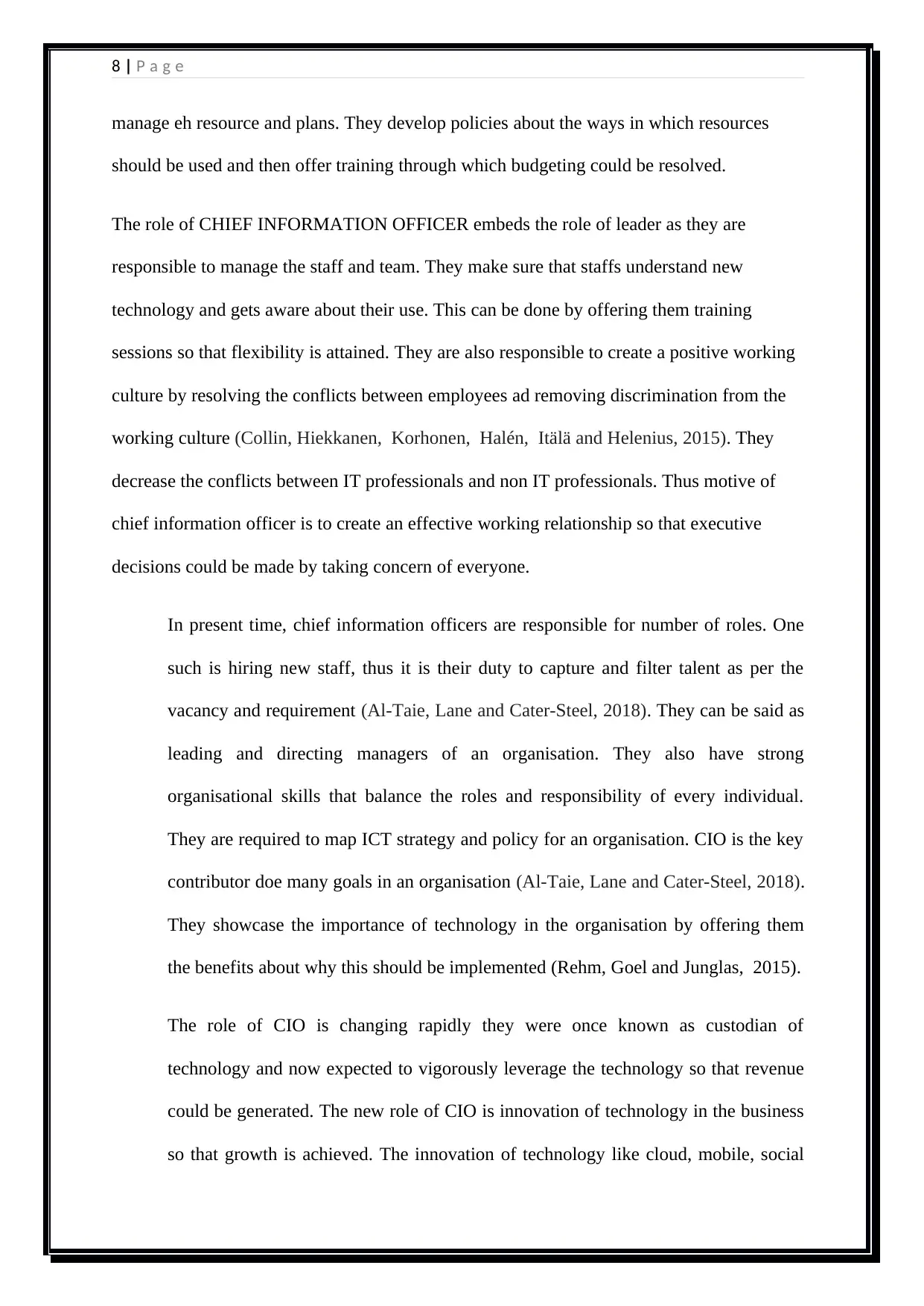
8 | P a g e
manage eh resource and plans. They develop policies about the ways in which resources
should be used and then offer training through which budgeting could be resolved.
The role of CHIEF INFORMATION OFFICER embeds the role of leader as they are
responsible to manage the staff and team. They make sure that staffs understand new
technology and gets aware about their use. This can be done by offering them training
sessions so that flexibility is attained. They are also responsible to create a positive working
culture by resolving the conflicts between employees ad removing discrimination from the
working culture (Collin, Hiekkanen, Korhonen, Halén, Itälä and Helenius, 2015). They
decrease the conflicts between IT professionals and non IT professionals. Thus motive of
chief information officer is to create an effective working relationship so that executive
decisions could be made by taking concern of everyone.
In present time, chief information officers are responsible for number of roles. One
such is hiring new staff, thus it is their duty to capture and filter talent as per the
vacancy and requirement (Al-Taie, Lane and Cater-Steel, 2018). They can be said as
leading and directing managers of an organisation. They also have strong
organisational skills that balance the roles and responsibility of every individual.
They are required to map ICT strategy and policy for an organisation. CIO is the key
contributor doe many goals in an organisation (Al-Taie, Lane and Cater-Steel, 2018).
They showcase the importance of technology in the organisation by offering them
the benefits about why this should be implemented (Rehm, Goel and Junglas, 2015).
The role of CIO is changing rapidly they were once known as custodian of
technology and now expected to vigorously leverage the technology so that revenue
could be generated. The new role of CIO is innovation of technology in the business
so that growth is achieved. The innovation of technology like cloud, mobile, social
manage eh resource and plans. They develop policies about the ways in which resources
should be used and then offer training through which budgeting could be resolved.
The role of CHIEF INFORMATION OFFICER embeds the role of leader as they are
responsible to manage the staff and team. They make sure that staffs understand new
technology and gets aware about their use. This can be done by offering them training
sessions so that flexibility is attained. They are also responsible to create a positive working
culture by resolving the conflicts between employees ad removing discrimination from the
working culture (Collin, Hiekkanen, Korhonen, Halén, Itälä and Helenius, 2015). They
decrease the conflicts between IT professionals and non IT professionals. Thus motive of
chief information officer is to create an effective working relationship so that executive
decisions could be made by taking concern of everyone.
In present time, chief information officers are responsible for number of roles. One
such is hiring new staff, thus it is their duty to capture and filter talent as per the
vacancy and requirement (Al-Taie, Lane and Cater-Steel, 2018). They can be said as
leading and directing managers of an organisation. They also have strong
organisational skills that balance the roles and responsibility of every individual.
They are required to map ICT strategy and policy for an organisation. CIO is the key
contributor doe many goals in an organisation (Al-Taie, Lane and Cater-Steel, 2018).
They showcase the importance of technology in the organisation by offering them
the benefits about why this should be implemented (Rehm, Goel and Junglas, 2015).
The role of CIO is changing rapidly they were once known as custodian of
technology and now expected to vigorously leverage the technology so that revenue
could be generated. The new role of CIO is innovation of technology in the business
so that growth is achieved. The innovation of technology like cloud, mobile, social
⊘ This is a preview!⊘
Do you want full access?
Subscribe today to unlock all pages.

Trusted by 1+ million students worldwide
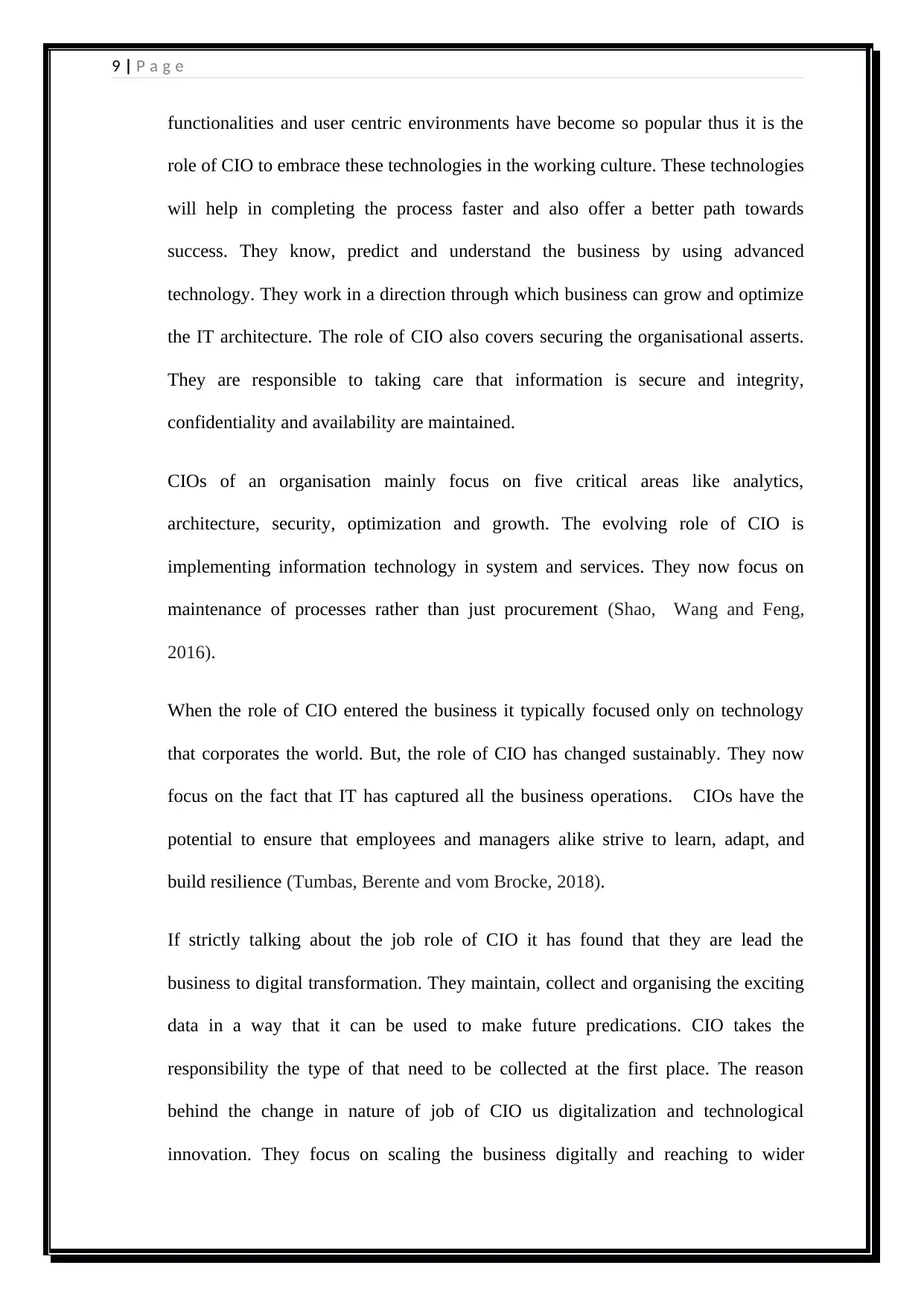
9 | P a g e
functionalities and user centric environments have become so popular thus it is the
role of CIO to embrace these technologies in the working culture. These technologies
will help in completing the process faster and also offer a better path towards
success. They know, predict and understand the business by using advanced
technology. They work in a direction through which business can grow and optimize
the IT architecture. The role of CIO also covers securing the organisational asserts.
They are responsible to taking care that information is secure and integrity,
confidentiality and availability are maintained.
CIOs of an organisation mainly focus on five critical areas like analytics,
architecture, security, optimization and growth. The evolving role of CIO is
implementing information technology in system and services. They now focus on
maintenance of processes rather than just procurement (Shao, Wang and Feng,
2016).
When the role of CIO entered the business it typically focused only on technology
that corporates the world. But, the role of CIO has changed sustainably. They now
focus on the fact that IT has captured all the business operations. CIOs have the
potential to ensure that employees and managers alike strive to learn, adapt, and
build resilience (Tumbas, Berente and vom Brocke, 2018).
If strictly talking about the job role of CIO it has found that they are lead the
business to digital transformation. They maintain, collect and organising the exciting
data in a way that it can be used to make future predications. CIO takes the
responsibility the type of that need to be collected at the first place. The reason
behind the change in nature of job of CIO us digitalization and technological
innovation. They focus on scaling the business digitally and reaching to wider
functionalities and user centric environments have become so popular thus it is the
role of CIO to embrace these technologies in the working culture. These technologies
will help in completing the process faster and also offer a better path towards
success. They know, predict and understand the business by using advanced
technology. They work in a direction through which business can grow and optimize
the IT architecture. The role of CIO also covers securing the organisational asserts.
They are responsible to taking care that information is secure and integrity,
confidentiality and availability are maintained.
CIOs of an organisation mainly focus on five critical areas like analytics,
architecture, security, optimization and growth. The evolving role of CIO is
implementing information technology in system and services. They now focus on
maintenance of processes rather than just procurement (Shao, Wang and Feng,
2016).
When the role of CIO entered the business it typically focused only on technology
that corporates the world. But, the role of CIO has changed sustainably. They now
focus on the fact that IT has captured all the business operations. CIOs have the
potential to ensure that employees and managers alike strive to learn, adapt, and
build resilience (Tumbas, Berente and vom Brocke, 2018).
If strictly talking about the job role of CIO it has found that they are lead the
business to digital transformation. They maintain, collect and organising the exciting
data in a way that it can be used to make future predications. CIO takes the
responsibility the type of that need to be collected at the first place. The reason
behind the change in nature of job of CIO us digitalization and technological
innovation. They focus on scaling the business digitally and reaching to wider
Paraphrase This Document
Need a fresh take? Get an instant paraphrase of this document with our AI Paraphraser
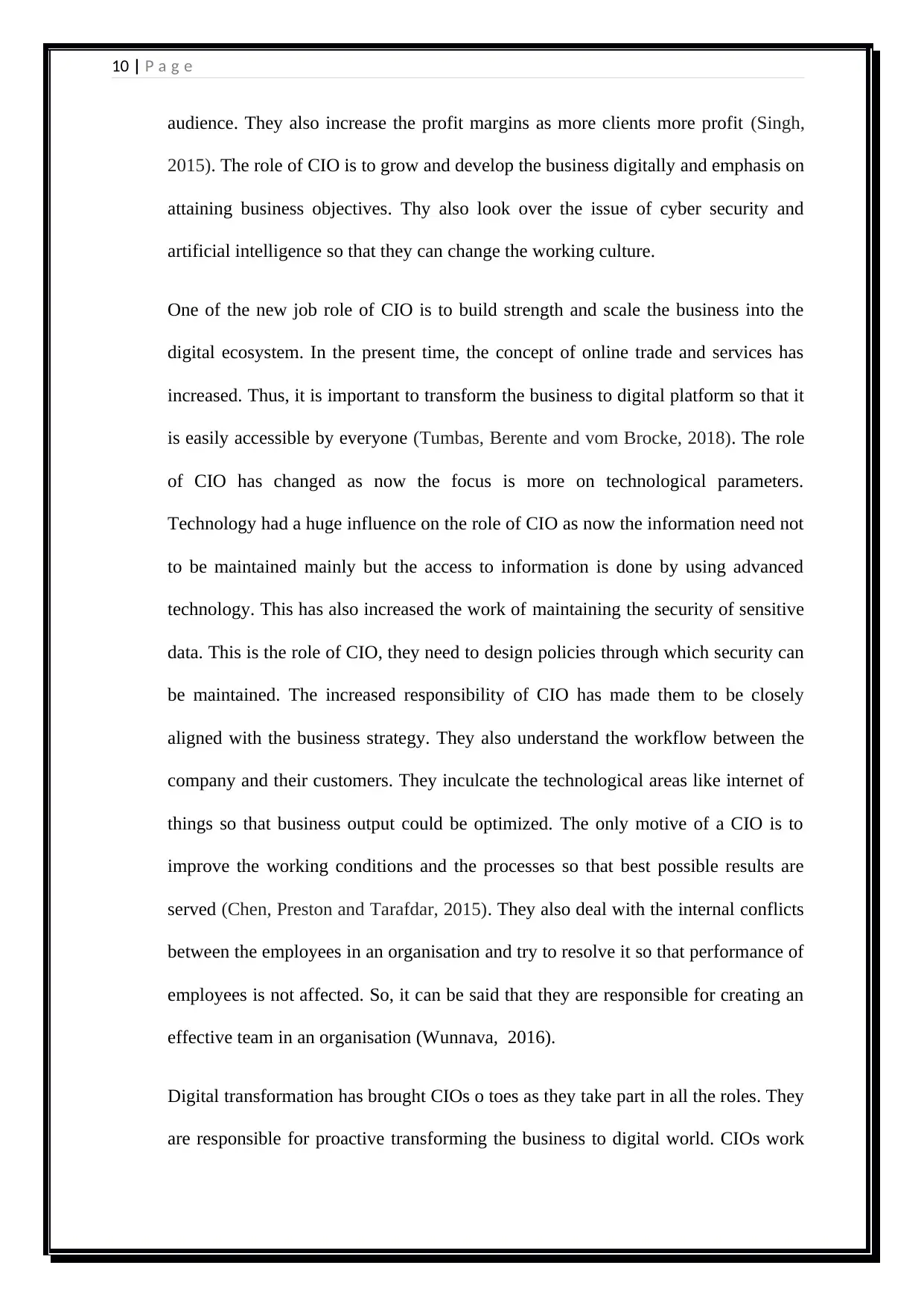
10 | P a g e
audience. They also increase the profit margins as more clients more profit (Singh,
2015). The role of CIO is to grow and develop the business digitally and emphasis on
attaining business objectives. Thy also look over the issue of cyber security and
artificial intelligence so that they can change the working culture.
One of the new job role of CIO is to build strength and scale the business into the
digital ecosystem. In the present time, the concept of online trade and services has
increased. Thus, it is important to transform the business to digital platform so that it
is easily accessible by everyone (Tumbas, Berente and vom Brocke, 2018). The role
of CIO has changed as now the focus is more on technological parameters.
Technology had a huge influence on the role of CIO as now the information need not
to be maintained mainly but the access to information is done by using advanced
technology. This has also increased the work of maintaining the security of sensitive
data. This is the role of CIO, they need to design policies through which security can
be maintained. The increased responsibility of CIO has made them to be closely
aligned with the business strategy. They also understand the workflow between the
company and their customers. They inculcate the technological areas like internet of
things so that business output could be optimized. The only motive of a CIO is to
improve the working conditions and the processes so that best possible results are
served (Chen, Preston and Tarafdar, 2015). They also deal with the internal conflicts
between the employees in an organisation and try to resolve it so that performance of
employees is not affected. So, it can be said that they are responsible for creating an
effective team in an organisation (Wunnava, 2016).
Digital transformation has brought CIOs o toes as they take part in all the roles. They
are responsible for proactive transforming the business to digital world. CIOs work
audience. They also increase the profit margins as more clients more profit (Singh,
2015). The role of CIO is to grow and develop the business digitally and emphasis on
attaining business objectives. Thy also look over the issue of cyber security and
artificial intelligence so that they can change the working culture.
One of the new job role of CIO is to build strength and scale the business into the
digital ecosystem. In the present time, the concept of online trade and services has
increased. Thus, it is important to transform the business to digital platform so that it
is easily accessible by everyone (Tumbas, Berente and vom Brocke, 2018). The role
of CIO has changed as now the focus is more on technological parameters.
Technology had a huge influence on the role of CIO as now the information need not
to be maintained mainly but the access to information is done by using advanced
technology. This has also increased the work of maintaining the security of sensitive
data. This is the role of CIO, they need to design policies through which security can
be maintained. The increased responsibility of CIO has made them to be closely
aligned with the business strategy. They also understand the workflow between the
company and their customers. They inculcate the technological areas like internet of
things so that business output could be optimized. The only motive of a CIO is to
improve the working conditions and the processes so that best possible results are
served (Chen, Preston and Tarafdar, 2015). They also deal with the internal conflicts
between the employees in an organisation and try to resolve it so that performance of
employees is not affected. So, it can be said that they are responsible for creating an
effective team in an organisation (Wunnava, 2016).
Digital transformation has brought CIOs o toes as they take part in all the roles. They
are responsible for proactive transforming the business to digital world. CIOs work
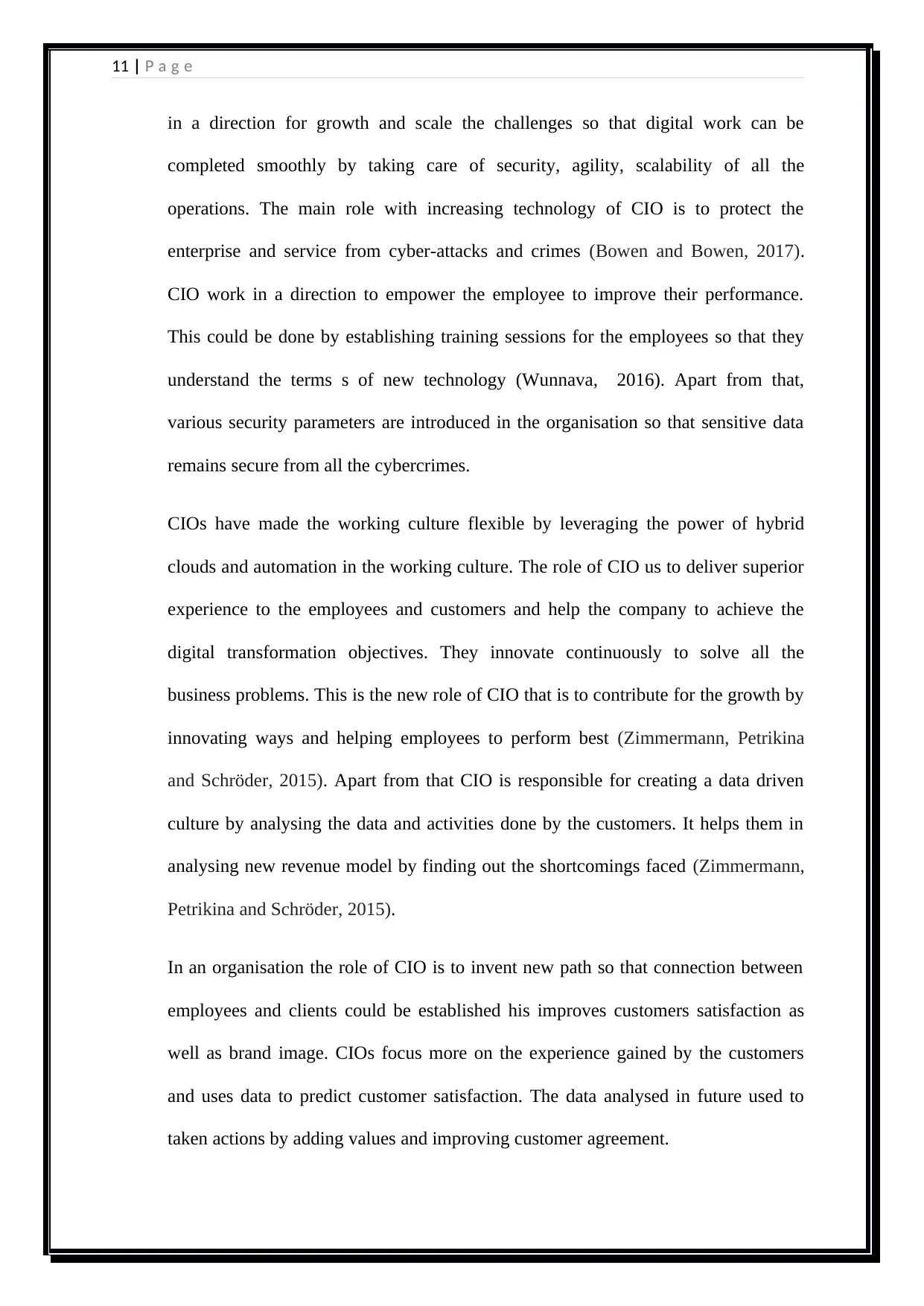
11 | P a g e
in a direction for growth and scale the challenges so that digital work can be
completed smoothly by taking care of security, agility, scalability of all the
operations. The main role with increasing technology of CIO is to protect the
enterprise and service from cyber-attacks and crimes (Bowen and Bowen, 2017).
CIO work in a direction to empower the employee to improve their performance.
This could be done by establishing training sessions for the employees so that they
understand the terms s of new technology (Wunnava, 2016). Apart from that,
various security parameters are introduced in the organisation so that sensitive data
remains secure from all the cybercrimes.
CIOs have made the working culture flexible by leveraging the power of hybrid
clouds and automation in the working culture. The role of CIO us to deliver superior
experience to the employees and customers and help the company to achieve the
digital transformation objectives. They innovate continuously to solve all the
business problems. This is the new role of CIO that is to contribute for the growth by
innovating ways and helping employees to perform best (Zimmermann, Petrikina
and Schröder, 2015). Apart from that CIO is responsible for creating a data driven
culture by analysing the data and activities done by the customers. It helps them in
analysing new revenue model by finding out the shortcomings faced (Zimmermann,
Petrikina and Schröder, 2015).
In an organisation the role of CIO is to invent new path so that connection between
employees and clients could be established his improves customers satisfaction as
well as brand image. CIOs focus more on the experience gained by the customers
and uses data to predict customer satisfaction. The data analysed in future used to
taken actions by adding values and improving customer agreement.
in a direction for growth and scale the challenges so that digital work can be
completed smoothly by taking care of security, agility, scalability of all the
operations. The main role with increasing technology of CIO is to protect the
enterprise and service from cyber-attacks and crimes (Bowen and Bowen, 2017).
CIO work in a direction to empower the employee to improve their performance.
This could be done by establishing training sessions for the employees so that they
understand the terms s of new technology (Wunnava, 2016). Apart from that,
various security parameters are introduced in the organisation so that sensitive data
remains secure from all the cybercrimes.
CIOs have made the working culture flexible by leveraging the power of hybrid
clouds and automation in the working culture. The role of CIO us to deliver superior
experience to the employees and customers and help the company to achieve the
digital transformation objectives. They innovate continuously to solve all the
business problems. This is the new role of CIO that is to contribute for the growth by
innovating ways and helping employees to perform best (Zimmermann, Petrikina
and Schröder, 2015). Apart from that CIO is responsible for creating a data driven
culture by analysing the data and activities done by the customers. It helps them in
analysing new revenue model by finding out the shortcomings faced (Zimmermann,
Petrikina and Schröder, 2015).
In an organisation the role of CIO is to invent new path so that connection between
employees and clients could be established his improves customers satisfaction as
well as brand image. CIOs focus more on the experience gained by the customers
and uses data to predict customer satisfaction. The data analysed in future used to
taken actions by adding values and improving customer agreement.
⊘ This is a preview!⊘
Do you want full access?
Subscribe today to unlock all pages.

Trusted by 1+ million students worldwide
1 out of 17
Related Documents
Your All-in-One AI-Powered Toolkit for Academic Success.
+13062052269
info@desklib.com
Available 24*7 on WhatsApp / Email
![[object Object]](/_next/static/media/star-bottom.7253800d.svg)
Unlock your academic potential
Copyright © 2020–2025 A2Z Services. All Rights Reserved. Developed and managed by ZUCOL.





